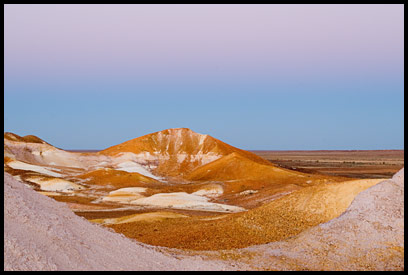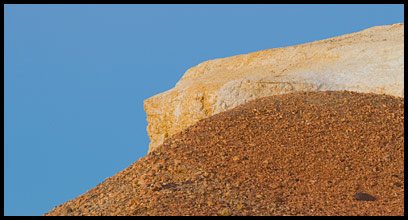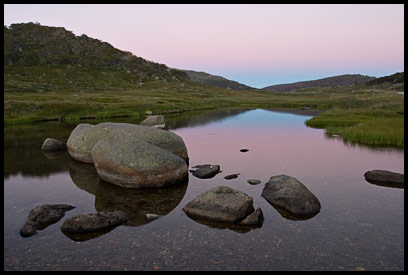|
Subscribe to this site's News feed via RSS:

Our partners:

|
Practical Colour Management
Many people have problems producing consistent and accurate colour with
their digital photography.
The colours in their home prints don't match the colours on their monitor,
or the colours on prints from the lab, or the colours on other peoples' computer.
Colour Management provides the tools to solve these problems.
To many people it's seen as a big, complex and expensive field.
But it really doesn't have to be that hard (or very expensive)!

| |
Belt of Venus over The Breakaways
|
If you know how it works you can skip forward to the list of
services we offer, otherwise here's a simple overview.
Colour management revolves around having a standard for colours (i.e. the things
that people perceive, as distinct from the pixel numbers used by various devices).
ICC profiles for each device describe the mathematics of how the colours map to pixel
numbers.
There's no concept of "matching the printer to the monitor", although when the profile
is correct for each device the printer should be comparable to the monitor.
Implementing colour management can be cut down into components based on the devices
involved:
|
Monitors
| |
The first step is to calibrate and profile the monitor(s) on your computer.
Then you'll know that the colours you see on your screen are accurate
(especially when using profile-aware software such as Photoshop).
When you share images with other people, they will see the same colours
(presuming they also have calibrated & profiled monitors) and when you send
your files off to a print lab the prints you get back should be accurate also
(at least with a good lab!).
To calibrate and profile your monitor, a device is attached to the front of
the monitor to accurately measure the colour, and this device connects to the
computer's USB port.
Profiling software draws various colours on screen, measures the effect, and
generates a profile. The calibration device can then be packed away until you
decide to re-profile.
When profiling your monitor, two steps are involved (often merged into one by
the profiling software, but logically still two steps).
Calibration adjusts the monitor to a "known state", typically so that greys are
neutral, the brightness is at the right level, the best contrast is achieved, etc.
Then an "ICC profile" is generated, which describes the behaviour of that
monitor so that software like Photoshop knows what pixel values to send to
the graphics card to produce specific colours on screen.
But having your screen set right is unfortunately just the start...
| |
Scanners
| |
Scanners can be profiled so that Photoshop/etc knows how to interpret
the pixel values reported by the scanner (i.e. exactly what colours they
represent).
To generate a profile, a special "target" page with known colours is scanned,
and then analysed by the profile software.
Scanners are easy to profile as they have a constant (internal) lighting source.
This is quite different from digital cameras where the lighting is constantly
changing.
Most photographers don't bother profiling their cameras, as they make their
critical colour decisions when working with their profiled monitors.
| |
Printers
| |
Once the monitor colours are accurate, some hobbyists adjust their printer
driver settings by hand to get prints they're happy with, but this can be done
more-accurately with a printer profile.
Just as with a monitor profile where software can calculate what pixel values
to send to the graphics card, a printer profile does the same for a printer.
However, the profile has to be specific to the particular combination of paper,
ink, and driver settings you use.
Each combination requires a separate profile.
If you're using a popular printer model and a popular paper from the printer manufacturer,
you might be able to download a profile for it from the manufacturer.
But this will be at best an approximation for your own printer,
and if you're doing anything differently (e.g. using a different paper, or different driver
settings, etc) the you need a custom profile specific to your equipment.
To generate a printer profile, a set of test pages is printed using your
printer (with the appropriate paper/etc as mentioned) and when they have cured
the paper colours are measured using a spectrophotometer.
The range of colours that can be shown on a printer (its "colour gamut") is
different from those that can be shown on your monitor,
With a good printer profile and a good screen profile, software such as
Photoshop also provides a "soft proofing" function so you can preview what
the print will look like without wasting any paper (even taking into account
things like the underlying paper colour).
| |
Room lighting and viewing conditions
| |
This is an important issue, but one glossed over by many people.
The lighting you view your prints under affects the way you interpret the
colours.
Not just because (for example) red light will accentuate the reds, and some
flourescent light will accentuate the greens, but also because of psychological
effects such as a bright coloured area in the corner of your vision affecting how
your mind perceives the other colours it can see.
The colour of the lighting in your work area is important, and not just for
the way it affects the way you perceive prints: window "daylight"
(which is usually blue as it's the light coming from the sky), incandescent
bulbs, flourescent strips, etc, can each affect the way you perceive the colours
on your monitor, even when the monitor's been calibrated and profiled.
Standard "daylight" light sources can easily be obtained, but even just
rearranging your work area can go a long way towards improving the situation.
| |
Data Projectors
| |
It is easy to get accurate colour through a projector.
Conceptually it's the same as for profiling a monitor, although specialised
equipment is required.
Having accurate colour on-screen facilitates Photoshop demonstrations,
photographic slideshows, and more.
Camera clubs such as those using projectors for regular competition display
often find this useful.
Be aware that the profile is only for the computer it was profiled with (as the
computer's video chips are part of what is measured when generating the profile):
for accuracy each computer needs its own profile for the projector.
Also note that the projection screen is part of the calibration, and that the
work needs to be done in the lighting conditions that the projector will be used
in (external lighting on the projection screen obviously affects the colours).
|
|
Some devices need regular profiling
| |
Profiles describe the behaviour of each device.
Unfortunately the behaviour of monitors (especially older CRTs) changes over time
so it's considered good practice to re-profile them regularly (e.g. monthly).
Even LCDs change colour over time, as their flourescent backlights slowly fade.
The equipment to calibrate and profile monitors ranges in cost from $140 up into
many thousands of dollars.
We supply huey and Eye-One Display devices, and have
some notes about the features of each.
Luckily the papers and inks provided by major manufacturers
(e.g. Canon / Epson / HP / Ilford) have quite good quality control
and tend not to vary over time.
Thus it's possible to get excellent results using printer profiles generated
by suppliers such as us,
without having to invest in the expensive spectrophotometer equipment yourself.
However the lights in scanners can fade over time, so these sometimes need
re-profiling as they get older.
|

| |
Ochre hills at dusk
|
What we can provide
I have been working with the practice and theory of colour management for many
years (existing customers include professional photographers, photo labs,
camera clubs and amateur photographers)
and have the expertise and equipment required to get you set up.
The basic services we provide (for Windows and OS X machines) are listed below.
If you have more-complicated needs, please contact us.
|
Printer profiling
| |
We can generate custom profiles for your home printer, or in fact any printer you send RGB data to.
You carefully print out specific test patterns, post them to us, and we email
the resulting profiles back to you.
For full details, see this page.
One pair of A4 test patterns (a total of 918 colour patches) is used to generate profiles for most papers.
With some printers it is possible to implement colour management for CD/DVD printing.
However, some software (e.g. EPSON Print CD) can not be profiled: it applies "magic" colour
correction to each CD as it's being printed.
By printing disks directly from within Photoshop (we do this with our R800) this can be avoided
and colour profiles can be generated/used.
If you're interested in doing this, see this page.
| |
Projector profiling
| |
If you have a data projector and attached computer (e.g. laptop) we can profile
them for you on-site.
| |
The lot
| |
With this service we visit your premises for 4 hours, and in this time:
-
Work with you to set up your studio environment for optimal colour work.
This includes looking at the lighting and monitor placement.
-
Calibrate and profile your monitor(s) either using your own calibrator, with one we
supply, or with my own equipment as a one-off (although it is highly recommended that
you get your own and regularly recalibrate the monitor).
We can provide you with a Gretag-Macbeth
Huey or Eye-One Display monitor calibrator.
As to which to choose, see these notes.
-
Profile your printer with your favourite paper.
At the end of this you will have custom profiles for two configurations, and be
familiar with obtaining and installing additional profiles.
The charge for any additional printer profiles generated as part of an on-site
visit is discounted by 10%.
-
Generate a custom profile for your reflective flatbed scanner.
-
If you have a data projector set up, the calibration & profiling of this can
be done during the on-site visit.
With all these profiles in place we will show you how to achieve consistent and
accurate colours when processing your photography.
|
Prices and Ordering
Payments can be made by cheque or money order (in Australian Dollars), by credit card, or by direct deposit.
The "Add to Basket" options below will build up a shopping basket with PayPal, with which you can pay with credit cards or other PayPal funds.
For the other payment options, see our payments page.
|
|
Printer (RGB) profiles
|
AU$60 each
Instructions
|
|
Colour Management Setup ("The lot")
Profile monitors, scanners, data projector,
two printer profiles
|
AU$350 (4-hour onsite visit)
|
| |
Calibrate a data projector
|
AU$180 (onsite visit)
|
| |
AU$40 for each additional computer
(if several will be used with the same projector)
or if the data projector is being profiled as part of another site visit.
|
|
Monitor calibrator: Eye‑One Display 2
(advanced: provides all monitor-calibration functions)
|
AU$400 +shipping (AU$15 within Australia)
|
|
Monitor calibrator: huey
(very basic device)
|
AU$140 +shipping (AU$15 within Australia)
|
| |
|
|

| |
Belt of Venus near Kosciusko
|
Our studio is located in Box Hill (a suburb of Melbourne, Vic).
The above "onsite" services can be conducted at your premises, up to 30 minutes
drive from our base.
More travel is possible, but would incur an additional charge.
The above prices all include GST.
|



